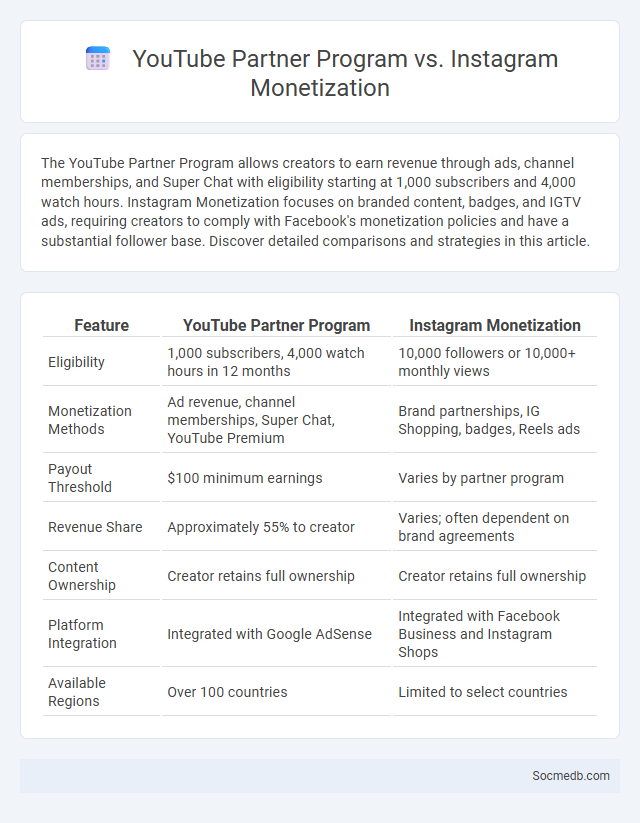
Photo illustration: YouTube Partner Program vs Instagram Monetization
The YouTube Partner Program allows creators to earn revenue through ads, channel memberships, and Super Chat with eligibility starting at 1,000 subscribers and 4,000 watch hours. Instagram Monetization focuses on branded content, badges, and IGTV ads, requiring creators to comply with Facebook's monetization policies and have a substantial follower base. Discover detailed comparisons and strategies in this article.
Table of Comparison
| Feature | YouTube Partner Program | Instagram Monetization |
|---|---|---|
| Eligibility | 1,000 subscribers, 4,000 watch hours in 12 months | 10,000 followers or 10,000+ monthly views |
| Monetization Methods | Ad revenue, channel memberships, Super Chat, YouTube Premium | Brand partnerships, IG Shopping, badges, Reels ads |
| Payout Threshold | $100 minimum earnings | Varies by partner program |
| Revenue Share | Approximately 55% to creator | Varies; often dependent on brand agreements |
| Content Ownership | Creator retains full ownership | Creator retains full ownership |
| Platform Integration | Integrated with Google AdSense | Integrated with Facebook Business and Instagram Shops |
| Available Regions | Over 100 countries | Limited to select countries |
Overview of YouTube Partner Program
The YouTube Partner Program enables content creators to monetize their videos through ads, channel memberships, and Super Chat features. Eligible channels must have at least 1,000 subscribers and 4,000 watch hours in the past 12 months, complying with YouTube's monetization policies and community guidelines. This program provides access to advanced analytics, copyright tools, and revenue-sharing opportunities, empowering creators to grow their audience and income.
Introduction to Instagram Monetization
Instagram monetization enables creators and businesses to generate revenue through features such as branded content, affiliate marketing, and in-app shopping. Leveraging Instagram's vast user base, individuals can capitalize on sponsored posts and collaborations to increase income streams effectively. Understanding Instagram's monetization policies and tools is crucial for maximizing earning potential on the platform.
What Is a Social Media Partner Program?
A Social Media Partner Program enables collaboration between businesses and social media platforms to enhance marketing reach and engagement. These programs provide exclusive tools, analytics, and support to help Your brand optimize content strategy and boost audience interaction. Participating in a partner program can increase visibility and drive targeted traffic through tailored campaigns and platform-specific features.
Eligibility Requirements Comparison
Eligibility requirements for social media platforms vary based on factors such as age, location, and user consent. Platforms like Facebook and Instagram require users to be at least 13 years old, while TikTok raises the minimum age to 16 in certain regions for enhanced compliance with privacy laws. Verification methods differ widely, with some platforms demanding phone numbers or email addresses to ensure authenticity and adherence to terms of service.
Revenue Streams: YouTube vs Instagram
YouTube primarily generates revenue through ad placements, channel memberships, and Super Chat features, allowing content creators to monetize views and interactions directly. Instagram's revenue streams focus more on sponsored posts, branded content, and in-app shopping, enabling influencers to earn through partnerships and product sales. Your choice between these platforms affects how you capitalize on audience engagement and diversify income sources.
Payout Structures and Thresholds
Social media platforms implement diverse payout structures and thresholds to manage user earnings, often varying by content type and region. Popular networks like YouTube, TikTok, and Instagram set minimum payout limits ranging from $10 to $100, which creators must reach before receiving payments via methods such as PayPal, direct bank transfer, or platform-specific wallets. These structures incentivize sustained content creation while ensuring transactional efficiency and compliance with financial regulations.
Content Guidelines and Policy Differences
Social media platforms maintain distinct content guidelines and policy differences to regulate user behavior and ensure community safety. Your content must align with each platform's rules, which often vary in tolerance for hate speech, misinformation, and graphic material. Understanding these differences helps optimize engagement while avoiding account suspension or content removal.
Audience Engagement and Growth Potential
Maximizing audience engagement on social media requires creating compelling, relevant content that resonates with Your target demographic to foster interaction and loyalty. Utilizing data analytics and platform algorithms helps identify growth potential by targeting high-value segments and optimizing post timing for increased visibility. Consistent engagement strategies, including responding to comments and leveraging interactive features, significantly enhance Your brand's reach and follower growth.
Pros and Cons of Each Monetization Method
Social media monetization methods vary in profitability and risk, with ad revenue offering steady income but relying heavily on platform algorithms that can limit Your reach. Sponsored content provides higher payouts and brand collaborations but may compromise authenticity and audience trust. Subscriptions and fan support create consistent recurring revenue but require constant engagement and valuable exclusive content to retain paying followers.
Choosing the Best Monetization Platform
Selecting the best monetization platform for social media hinges on understanding your audience demographics and content type. Platforms like YouTube excel with video ads and memberships, while Instagram offers lucrative brand partnerships and shopping features. Align Your content strategy with platform-specific monetization tools to maximize earnings and engagement.
 socmedb.com
socmedb.com